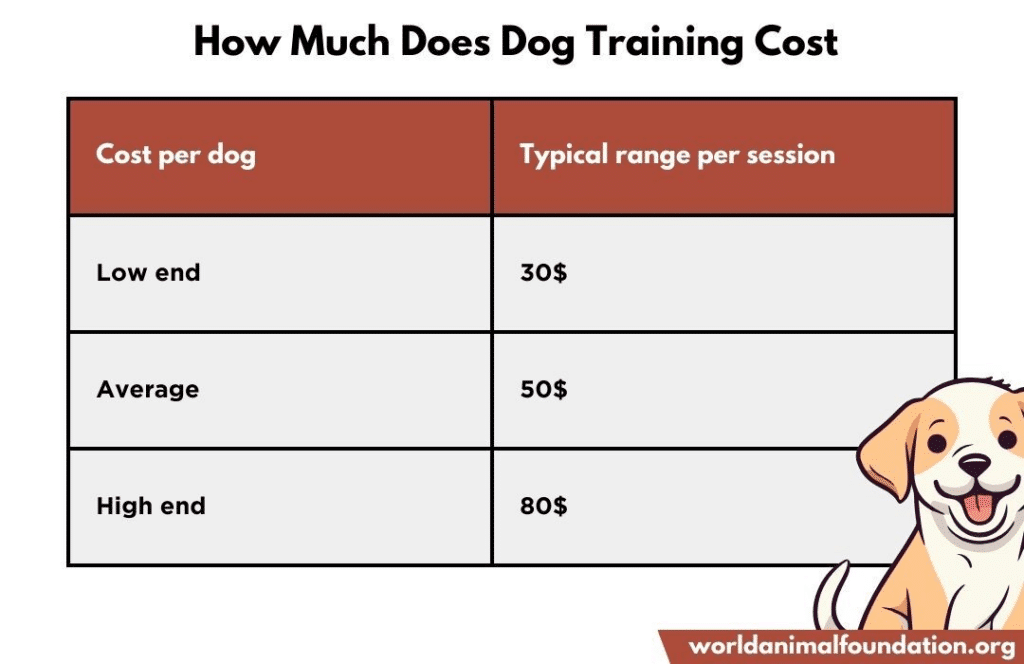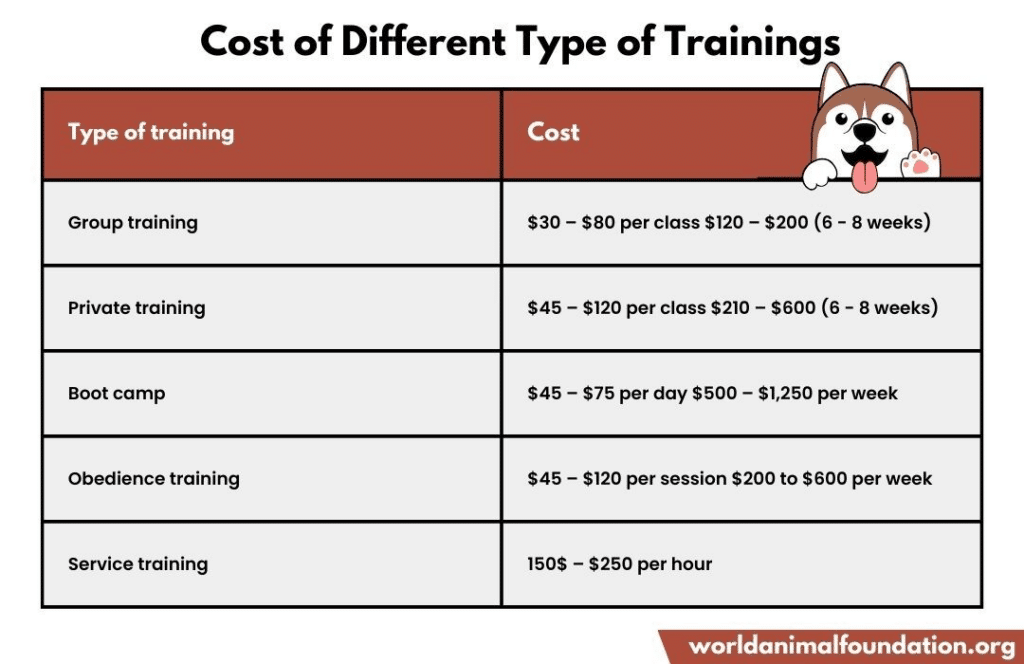Are you considering dog training or fostering but not sure if you can afford it? This article will guide you through the ins and outs of budgeting for dog training and fostering, giving you a clear understanding of what to expect. From the cost of classes and supplies to unexpected expenses, we have got you covered. By the end of this article, you will have a comprehensive view of the financial aspects of embarking on the journey of dog training or fostering, allowing you to make an informed decision while keeping your furry friend's well-being in mind.

This image is property of worldanimalfoundation.org.
Costs of Dog Training
Basic obedience training
Basic obedience training is an essential part of ensuring that your dog is well-behaved and responsive to your commands. The cost of basic obedience training can vary depending on factors such as the trainer's experience, location, and the duration of the training sessions. On average, you can expect to pay around $30 to $80 per hour for basic obedience training.
Specialized training
In addition to basic obedience training, some dogs may require specialized training to address specific behavior issues or skills. Specialized training can include areas such as agility training, therapy dog training, or search and rescue training. The cost of specialized training can be higher than basic obedience training, typically ranging from $50 to $150 per hour.
Private training sessions
Private training sessions offer personalized attention and can be tailored to your dog's specific needs. The cost of private training sessions will depend on the trainer's experience and location. On average, private training sessions can range from $50 to $100 per hour. While private training sessions may be more expensive, they can be beneficial if your dog requires individualized attention.
Group training classes
Group training classes are a more affordable option compared to private training sessions. In group classes, your dog will have the opportunity to socialize with other dogs and learn alongside them. The cost of group training classes can vary depending on factors such as the size of the class and the duration of each session. On average, group training classes can range from $20 to $50 per session.
Training supplies and equipment
In addition to the cost of training sessions, you will also need to budget for training supplies and equipment. Training supplies can include treats, clickers, leashes, and training pads. The cost of training supplies will depend on the specific items you need and where you purchase them. It is a good idea to research prices and compare options to find the best deals.
Factors Affecting Training Costs
Dog's age and breed
The age and breed of your dog can have an impact on the cost of training. Puppies may require more frequent training sessions and may be enrolled in classes specifically designed for their age group. Certain breeds may also require specialized training techniques due to their specific characteristics and tendencies. It is important to consider these factors when budgeting for training costs.
Training methods
Different trainers may use different methods and techniques when it comes to dog training. Some trainers may focus on positive reinforcement techniques, while others may use more traditional methods. The cost of training can vary depending on the training method used. It is recommended to research and choose a training method that aligns with your values and your dog's needs.
Training duration
The duration of the training program or sessions can also affect the overall cost. For example, a comprehensive training program that spans several weeks or months may cost more than a shorter program. Additionally, longer training sessions may be more expensive than shorter ones. Consider your dog's training needs and your budget when deciding on the duration of the training.
Geographical location
The cost of dog training can vary depending on your geographical location. Urban areas or regions with a higher cost of living may have higher training costs compared to rural areas. It is important to take this into account when budgeting for training expenses. Research local trainers and training facilities to get an idea of the average cost in your area.
Budgeting for Dog Training
Researching training options
Before starting your dog's training journey, it is important to spend time researching different training options available in your area. Look for trainers with positive reviews and a good reputation. Consider the type of training your dog needs and find trainers who specialize in that area. Researching different options will give you a clear idea of the average cost and help you plan your budget accordingly.
Comparing prices
Once you have a list of potential trainers or training programs, take the time to compare prices. Contact different trainers and inquire about their rates. Keep in mind that the lowest price may not always be the best option. Look for a balance between affordability and quality. Additionally, inquire about any package deals or discounts that trainers may offer. Comparing prices will help you make an informed decision and find the best value for your money.
Setting a training budget
After researching and comparing prices, it is important to set a training budget. Determine how much you are willing and able to spend on your dog's training. Consider your overall financial situation and prioritize your dog's training needs. Allocate a specific amount for training expenses and stick to it. Having a budget in place will help you manage your finances and avoid overspending.
Prioritizing essential training needs
While it would be ideal to provide your dog with all types of training available, it may not always be feasible within your budget. Prioritize essential training needs based on your dog's behavior and specific requirements. For example, if your dog has issues with leash pulling or obedience, focus on basic obedience training first. By prioritizing essential training needs, you can ensure that your dog receives the necessary skills and behaviors for a well-rounded training foundation.
Considering long-term training costs
When budgeting for dog training, it is important to consider the long-term costs. Training is not a one-time expense. Dogs may require ongoing training sessions or periodic refreshers to maintain their skills. Take into account the potential costs of additional training in the future and factor it into your budget. Planning for long-term training costs will help you avoid financial strain down the road.
Costs of Fostering a Dog
Food and treats
One of the main costs associated with fostering a dog is providing them with a nutritious and balanced diet. The cost of dog food can vary depending on the brand, quality, and size of the dog. Treats are also necessary for training and rewarding good behavior. Consider the nutritional needs of the dog when purchasing food and treats, as well as your budget constraints.
Veterinary care
Fostering a dog also involves providing veterinary care. This includes regular check-ups, vaccinations, and potential medical treatments. The cost of veterinary care can vary depending on the dog's health condition and any specific needs they may have. It is important to budget for routine veterinary expenses to ensure the dog's overall well-being.
Medications and vaccinations
In addition to regular veterinary care, some dogs may require medications or specific vaccinations. These can include flea and tick prevention, heartworm prevention, or medications for chronic conditions. The cost of medications and vaccinations will vary depending on the dog's needs. Consult with a veterinarian to determine the necessary medications and factor their cost into your fostering budget.
Grooming
Fostering a dog may also involve grooming expenses. Grooming includes activities such as bathing, brushing, and nail trimming. The cost of grooming can vary depending on the size and breed of the dog. Some dogs may require more frequent grooming sessions or specialized grooming services. Research grooming options in your area and include grooming expenses in your budget.
Toys and supplies
Providing toys and supplies for the foster dog is essential for their mental and physical stimulation. Toys can help keep the dog entertained and prevent destructive behavior. Additionally, necessary supplies such as bowls, bedding, and crates should be taken into account. The cost of toys and supplies will depend on the specific items you choose and where you purchase them. Look for affordable options without compromising on quality.
Pet insurance
Considering pet insurance for your foster dog is a wise investment. Pet insurance can help cover unexpected veterinary expenses and provide peace of mind. The cost of pet insurance will depend on several factors, including the dog's age, breed, and any pre-existing conditions. Research different pet insurance providers and policies to find one that fits within your budget and provides adequate coverage.
This image is property of qph.cf2.quoracdn.net.
Factors Affecting Fostering Costs
Size and breed of the dog
The size and breed of the dog can impact the overall cost of fostering. Larger dogs may require more food, higher doses of medications, and bigger crates or beds. Certain breeds may have specific dietary needs or be predisposed to certain health conditions, which can affect veterinary costs. Consider the size and breed of the dog when estimating fostering expenses.
Health conditions
If the foster dog has any pre-existing health conditions or requires ongoing medical treatments, it can significantly impact the fostering costs. Dogs with chronic conditions may require regular medications or specialized veterinary care. Discuss any potential health conditions with the rescue organization or shelter before committing to foster. Being aware of the dog's health needs will help you plan and budget accordingly.
Age of the dog
The age of the dog can also affect the fostering costs. Puppies may require additional vaccinations and more frequent veterinary check-ups. Older dogs may have age-related health issues that need to be addressed. Consider the age of the dog when budgeting for fostering expenses and ensure that you can provide the necessary care and attention for the dog's specific age group.
Specific dietary needs
Some dogs may have specific dietary needs or food allergies that require them to be on specialized diets. These diets can be more expensive than standard dog food. If you are fostering a dog with specific dietary needs, factor in the cost of specialized food when budgeting. Consult with a veterinarian to determine the best diet for the dog's health and budgetary constraints.
Geographical location
Similar to training costs, the geographical location can have an impact on the overall fostering costs. Areas with a higher cost of living may have higher expenses for food, veterinary care, and supplies. It is important to research the average costs in your area and consider any regional variations when planning your fostering budget.
Budgeting for Dog Fostering
Estimating monthly expenses
To budget effectively for dog fostering, it is important to estimate your monthly expenses. Take into account the costs of food, veterinary care, grooming, supplies, and any other potential expenses. Be thorough in your estimation to ensure that you have enough funds to provide proper care for the foster dog.
Creating a fostering budget
Once you have estimated your monthly expenses, create a fostering budget. Determine how much you can allocate toward fostering each month and set aside that amount. Make sure to include a buffer for any unexpected expenses that may arise. Creating a budget will help you stay organized and ensure that you are financially prepared to provide for the foster dog's needs.
Seeking financial assistance or sponsorships
If you find yourself struggling to cover the fostering expenses, consider seeking financial assistance or sponsorships. Some organizations or individuals may be willing to help with the costs of fostering. Reach out to local rescue organizations or animal welfare groups to inquire about any available assistance programs. Additionally, you can explore crowdfunding platforms as a way to raise funds for your fostering efforts.
Saving on pet supplies
To cut down on fostering costs, look for ways to save on pet supplies. Purchase supplies in bulk or take advantage of sales and discounts offered by pet stores. Consider buying generic or store-brand items that are often more affordable than name brands. You can also look for gently used supplies from local pet supply exchanges or online classifieds. Saving on pet supplies can help stretch your fostering budget further.
Planning for unexpected expenses
When budgeting for dog fostering, it is crucial to plan for unexpected expenses. Emergencies or unforeseen circumstances can arise, requiring immediate veterinary care or additional expenses. Set aside a portion of your fostering budget for emergencies to ensure that you are prepared to handle unexpected costs without financial strain.

This image is property of worldanimalfoundation.org.
Additional Considerations
Training and fostering grants
There are various organizations and foundations that offer grants specifically for dog training and fostering. These grants can help offset the costs of training programs, supplies, and veterinary care. Research local and national grant opportunities and find out if you qualify. Applying for grants can provide much-needed financial assistance and help make training and fostering more accessible.
Volunteer or foster reimbursement programs
Some rescue organizations or shelters may offer volunteer or foster reimbursement programs. These programs can provide monetary compensation or reimbursements for certain expenses incurred while fostering a dog. Inquire with local organizations about any available programs and eligibility requirements. Participating in such programs can help offset the costs of fostering and make it more financially manageable.
Tax deductions and credits
In some cases, expenses related to dog training and fostering may be tax-deductible or eligible for tax credits. Keep detailed records of your training and fostering expenses, including receipts and invoices. Consult with a tax professional or refer to relevant tax laws in your country to determine if you are eligible for any tax deductions or credits. Taking advantage of these tax benefits can help reduce the overall cost of training and fostering.
Local resources and support groups
Take advantage of local resources and support groups when it comes to dog training and fostering. Local rescue organizations or shelters may offer discounted or free training classes or behavior consultations. They can also provide valuable advice and support throughout the fostering process. By tapping into these resources, you can gain access to affordable training options and a network of experienced individuals who can guide you on your fostering journey.
Budgeting for unforeseen circumstances
While it is impossible to anticipate all unforeseen circumstances, it is important to budget and plan for them. Prepare for potential unexpected expenses by setting aside a small portion of your budget for emergencies or unforeseen circumstances. Having a financial cushion will give you peace of mind and ensure that you are prepared to handle any unexpected costs that may arise during the training or fostering process.
Tips for Cost-Effective Training and Fostering
Researching affordable training options
When looking for training options, research and compare prices to find the most affordable option that still meets your dog's needs. Look for trainers who offer group classes or package deals that can save you money. Additionally, consider online resources and tutorials that offer free or low-cost training tips and exercises. By researching and exploring affordable options, you can provide quality training without breaking the bank.
Utilizing online resources and tutorials
The internet provides a wealth of information and resources for dog training and fostering. Take advantage of online resources, such as training videos, blogs, and forums. These resources can provide valuable insights and guidance for training your dog at home. Additionally, there are online communities where you can seek advice and support from experienced trainers and foster parents. Utilizing online resources can be a cost-effective way to enhance your training and fostering journey.
Building a DIY training area
You don't always need a professional training facility to train your dog. Consider building a DIY training area in your backyard or even indoors. Use simple materials such as cones, jump poles, or agility tunnels to create a training space. DIY training areas are cost-effective and can provide a fun and unique training environment for your dog. With a little creativity, you can create an engaging training area without breaking the bank.
Engaging in community training sessions
Look for community training sessions or events in your area. Many cities offer free or low-cost training classes or workshops where you can learn new training techniques and socialize your dog. Engaging in community training sessions not only provides cost-effective training but also allows you to connect with other dog owners and trainers in your area. These sessions can be a valuable resource for training and fostering support.
Seeking discounted or free fostering supplies
When it comes to fostering supplies, look for discounted or free options. Contact local pet stores, shelters, or rescue organizations to inquire about any available discounts or donations. Some organizations may offer discounted or subsidized supplies for foster parents. Additionally, consider reaching out to friends, family, or online communities to see if anyone has extra supplies they are willing to donate. By seeking discounted or free supplies, you can lower the overall cost of fostering.

This image is property of static.wixstatic.com.
Conclusion
Budgeting for dog training and fostering is essential to ensure that you can provide the necessary care and support for your furry friend. Consider all the costs associated with each aspect of training and fostering, including training sessions, supplies, and veterinary care. Take into account factors such as your dog's age, breed, and health condition, as well as your geographical location. Research different training options and compare prices to find the best value for your money. Create a budget, prioritize essential needs, and plan for long-term costs. Seek financial assistance or sponsorships if needed and save on pet supplies whenever possible. Take advantage of training and fostering grants, reimbursement programs, and tax benefits. Utilize online resources, community training sessions, and DIY solutions to make training and fostering more cost-effective. With careful planning and budgeting, you can ensure a responsible and affordable journey in dog training and fostering.


